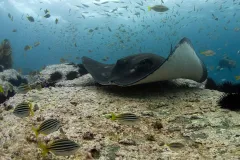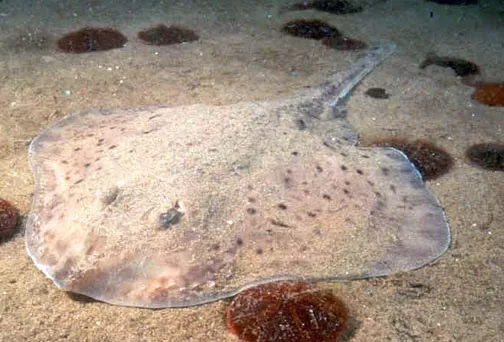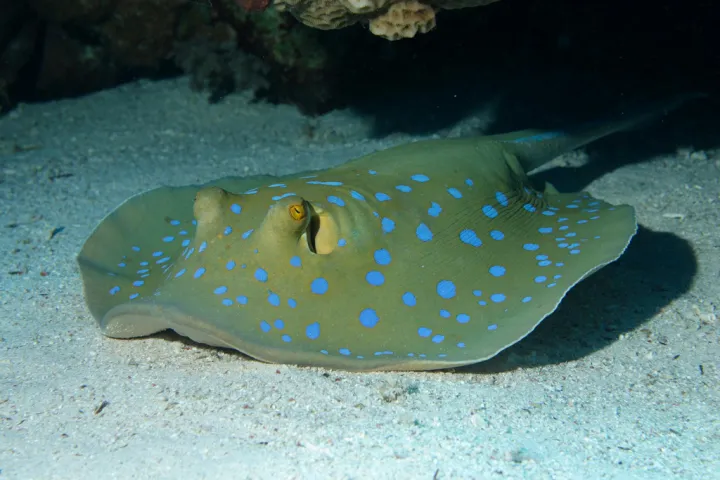Shark Cousins: the Skates and Rays

Sharks with their toothy grins and fearsome reputations are favorite ocean animals that get a lot of the spotlight, and with such famous relatives, the skates and rays often are left with little recognition. But skates and rays are deserving of attention too. With massive wingspans, some can reach lengths of around 23 feet (7 m), while others can leap through the ocean surface into the air. And though sharks boast a set of sharp teeth for protection, the barbs of rays are equally deadly. Here, we shed some light on why both skates and rays, the forgotten cousins of sharks, are deserving of your love and attention.
Both skates and rays are elasmobranchs, just like sharks, meaning they have skeletons made from soft cartilage rather than bone. There are 26 families of rays in four orders, which include the skates as well as stingrays, guitarfishes, sawfishes, and rhino rays. Together these families form the Batoidea superorder of cartilaginous fishes, a group of over 600 species. While sharks have a body shape like other fish, most skates and rays have flattened bodies that are wing-like, helping them glide effortlessly through the water. Though they often are mistaken for one another, subtle differences in the body shape of rays and skates can help distinguish between the two. Skates possess a prominent rostrum (a pointy snout-like structure), giving their body an elongated triangular shape. Often, their bodies are more rounded and they have a dorsal fin at the end of their tail. Rays, on the other hand, are often diamond shaped with more distinct wing-like pectoral fins. The manta ray boasts an impressive 30-foot-wide wingspan, making them appear almost otherworldly as they gracefully move through the water.
The Mobula rays use their wing-like bodies to propel themselves out of the water in a burst of speed. Known as flying rays or devil rays, they can be seen migrating in schools numbering in the thousands, all jumping out of the water together. Surprisingly the flying Mobula rays are also exceptional deep divers and have a special anatomy that facilitates heat exchange in the brain—an important adaptation for staying warm when diving to freezing depths of over 6,500 feet (2,000 meters).
Deep-sea skates live even deeper. Denizens of the deep, they scavenge the base of the continental slope at close to 9,000 feet (3,000 meters) where their prey hide in the seafloor. Not only is this a great hunting ground, but the hydrothermal vents that tower up from the seafloor spew hot water and provide a warmed environment to incubate their young. Unlike rays that give live birth to their young, skates are oviparous, meaning the young develop in egg sacks. The deep-sea skates lay their eggs, called mermaid purses, around the vents, a strategy that quickens the development of the growing baby skate.
Another way to tell rays and skates apart is by looking at their tails. Skates have thick and shorter tails while a ray tail is more whiplike. Additionally, rays possess barbs on their tails, some of which are venomous and help protect against predators. The barbs are lined with flat spines that penetrate into the intended target. The bluespotted ribbontail ray is one such ray with a venomous spike. Though more likely to run away from a fight than instigate one, this beautiful ray uses its blue-spotted coloration as a warning to potential predators to stay away or suffer the consequences—a painful stab of venom that in rare instances can be deadly.
Besides their interesting anatomy, Batoids are an essential part of ocean ecosystems around the world. They have adapted to occupy a wide range of marine habitats, from the icy depths of the Arctic and Antarctic to the warm tropical waters. Skates are often found in temperate and colder regions, dwelling on the ocean floor, where they feed on crustaceans, mollusks, and small fish. Rays, on the other hand, can be found in both shallow coastal waters and deeper ocean environments. Some species of rays are pelagic, meaning they roam the open ocean, while others prefer benthic habitats close to the ocean floor. The spotted eagle ray is a common reef visitor that spends most of its time actively swimming in the open ocean while the southern stingray, a close relative, lazes camouflaged under the sand along the seafloor.
But many ray and skate species are in trouble. Overfishing and habitat destruction has led to several populations declining and becoming threatened or endangered. Rays are more endangered than sharks, and the Maugean Skate may be the first shark or shark relative to go extinct in modern times. The common skate, once so abundant it was seen along all Northern Atlantic shores, is now critically endangered and is only seen off the coast of Scotland. The skates are targeted for their meat to be sold as “ray wings” and are often caught as bycatch in trawlers. Also, suspiciously cheap "fried scallops" is often stingray meat. People will use a round cookie cutter to cut the ray meat so it looks like a scallop. This is why it is so critical that people become aware of their existence. With awareness, perhaps, people will begin to care and enact protections for the species. Hopefully, years into the future beachcombers will continue to find mermaid’s purses along the shore and wonder about the creatures that made them.
_______________________________
Editor's Note: this article was reviewed with the help of David Shiffman.




